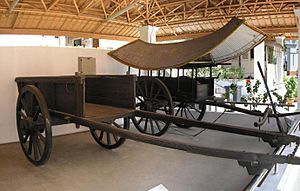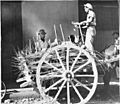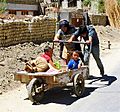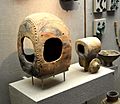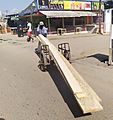Cart facts for kids
A cart is a simple vehicle that usually has two wheels. It's made for carrying things and is often pulled by animals like horses or oxen. A handcart is similar but is pushed or pulled by people. Carts are different from wagons, which are heavier vehicles with four wheels, often pulled by more than one animal. They are also different from carriages, which are mainly used to carry people.
Over time, the word "cart" has grown to mean almost any small vehicle. This includes things like shopping carts or golf carts, even if they have more than two wheels or are powered by a motor.
Animals that pull carts can be horses, ponies, mules, oxen, water buffalo, or donkeys. Sometimes, even smaller animals like goats or large dogs have been used.
History of Carts
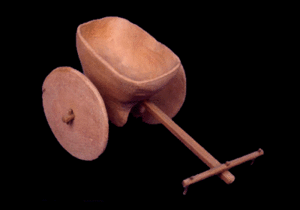
Carts have been around for a very long time! They are mentioned in ancient writings from as far back as 2000 BCE. For example, the ancient Indian book called the Rigveda talks about how men and women are as important as the two wheels of a cart.
People have also used handcarts, which are pushed by humans, all over the world. In the 1800s, some Mormon handcart pioneers used handcarts to travel across the plains of the United States between 1856 and 1860.
The story of carts is closely connected to the history of the wheel itself, as carts wouldn't exist without wheels!
Different Kinds of Carts
Larger carts are often pulled by animals like horses, mules, or oxen. People have used these kinds of carts ever since the wheel was invented, which was about 6,000 years ago. Carts are sometimes named after the animal that pulls them, like a horsecart or an oxcart. Today, horsecarts are still used in special competitions.
A dogcart is usually a cart made to carry hunting dogs. It's an open cart with two seats facing away from each other, and the dogs could be kept in a space behind the rear-facing seat.
The word "cart" can also mean different types of lightweight, two-wheeled vehicles, especially those used for fun or sports. These could be pulled by a horse, pony, or even a dog. Here are some examples:
- Cocking cart: A short, high, two-wheeled cart with a seat for a helper behind the main seating area.
- Dogcart: A light, often high, two-wheeled cart usually pulled by one horse, with two seats facing back-to-back.
- Donkey cart: A cart with a low axle and two seats along the sides. It's also called a pony cart or tub-cart.
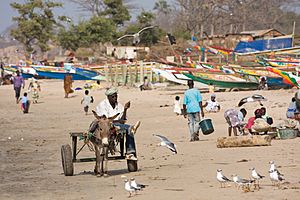
- Float: This cart has a very low loading area, making it easy to carry heavy or wobbly items like milk containers. The name "milkfloat" is still used today for vehicles that deliver milk.
- Governess cart: A light, two-wheeled cart that you enter from the back. It's often made partly or entirely of woven material and has seats for two people along each side. It's also called a governess car or tub-cart.
- Ralli cart: A light, two-wheeled, horse-drawn cart for two people facing forward, or four people (two forward, two backward). The seat can be moved to balance the cart depending on how many people are riding.
- Stolkjaerre: A two-wheeled cart from Norway with a front seat for two people and a back seat for the driver.
- Tax cart: A spring cart that used to have a small tax on it in England. It was also called a taxed cart.
- Whitechapel cart: A light, two-wheeled spring cart, often used by families or for small deliveries.
A person who builds carts is called a cartwright. The last name "Carter" also comes from the job of transporting goods by cart or wagon.
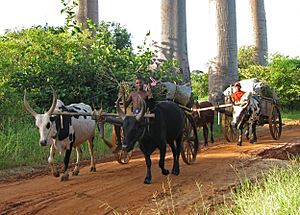
Carts come in many shapes, but their main purpose is always to move materials or keep things together in a portable way. Some carts have two long poles, called shafts, that run along each side of the animal pulling the cart. These shafts help support the cart's weight. Other carts, especially those pulled by oxen or buffalo, might have a single pole between two animals.
The ropes or chains that connect the animal to the cart are called traces. These traces attach to the cart's axle or to the shafts. They are then connected to a collar (for horses), a yoke (for other large animals), or a harness (for dogs or smaller animals). Traces can be made from strong materials like iron chains for heavy loads, or leather and rope for lighter use.
Modern Carts
Today, one of the most common types of carts not pulled by animals is the shopping cart. In British English, it's often called a shopping wiktionary:trolley. Shopping carts first appeared in Oklahoma City in 1937. The idea of a "shopping cart" is also used online for a list of items you plan to buy.
In golf, there are manual push or pull carts, and electric carts. These are designed to carry a golfer's bag, clubs, and other gear. There are also larger golf carts, which are powered vehicles that carry golfers and their equipment around the course, making it easier than walking.
A Porter's trolley is a small, wheeled platform that people push by hand. It's also known as a baggage cart.
Autocarts are small, hand-pushed utility carts that can fold up for easy storage in vehicles. They help people carry groceries, tools, or supplies without needing plastic or paper bags.
A soap-box cart (also known as a Billy Cart or Go-Cart) is a popular project for kids. These are usually homemade carts on wheels, often pushed or pedaled, and sometimes used for fun races.
An electric cart is simply a vehicle powered by electricity.
The term "Go-Kart" (or just "Kart"), which has been around since 1959, refers to a tiny race car with a frame and a small engine. The older term go-cart originally meant a type of chair carried by people or a device to help babies learn to walk.
Carts have been used for over 4,000 years all around the world. Today, we still use many types of carts, with the shopping cart being a very common example.
Images for kids
-
A donkey cart is often used for transport in the Thar Desert.
-
Kids riding in a handcart in Leh, Ladakh, India.
-
A cart with iron wheels on a farm in Chinawal village, India.
-
A horsecart in Santiago de Cuba.
-
A Chinese Sui Dynasty (581–618 AD) cart figurine pulled by a bull.
-
Mormon handcart pioneers crossing the Platte River in a modern reenactment of an 1856 journey.
-
A walking cart, used for long-distance travel, seen near Michigan's Mackinac Bridge.
-
A donkey cart used for carrying goods in northern Ghana.
See also
 In Spanish: Carro para niños
In Spanish: Carro para niños


